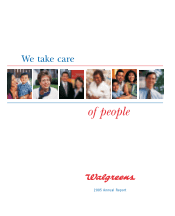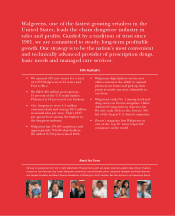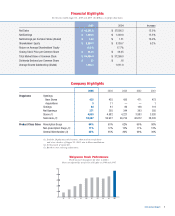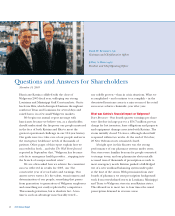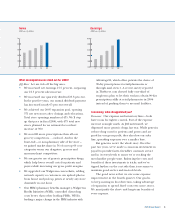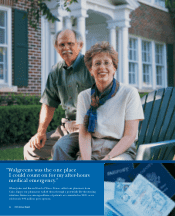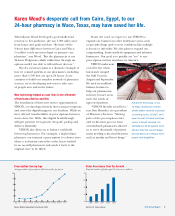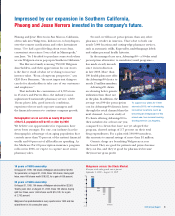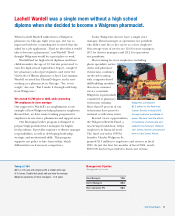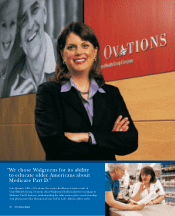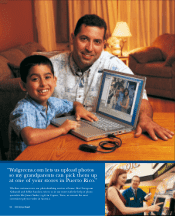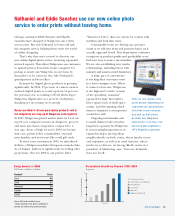Walgreens 2005 Annual Report Download - page 9
Download and view the complete annual report
Please find page 9 of the 2005 Walgreens annual report below. You can navigate through the pages in the report by either clicking on the pages listed below, or by using the keyword search tool below to find specific information within the annual report.
Older Americans Fuel Rx Growth
Projected number of people aged 65 and over in millions
Source: U.S. Census BureauSource: Medical Expenditure Panel Survey, 2002
Prescription Use by Age
Average number of prescriptions filled annually, per person
Karen Wood’s desperate call from Cairo, Egypt, to our
24-hour pharmacy in Waco, Texas, may have saved her life.
When Karen Wood developed a potentially fatal
reaction to her medicine, she was 7,000 miles away
from home and panic-stricken. “Because of the
8-hour time difference between Cairo and Waco,
I couldn’t reach my neurologist or primary care
physician,” says Wood. “But the pharmacist at my
24-hour Walgreens calmly walked me through my
options until I was able to talk with my doctors.”
Wood’s overseas trauma is a dramatic example of
how we counsel patients at our pharmacies, including
more than 1,500 that are open 24 hours. As we
continue to build our seamless network of pharmacy
services, we’re developing new ways to take care
of people now and in the future.
New technology helped us save lives in the aftermath
of Hurricanes Katrina and Rita
The foundation of these new service opportunities is
VISION, a technological system that scans prescriptions
and stores the digital images in our database. While we
have offered transferability of prescriptions between
stores since the 1980s, this digital breakthrough
will give patients even greater drop-off, pickup and
delivery flexibility.
VISION also allows us to balance workloads
between pharmacies. For example, a high-volume
pharmacy can transmit a prescription to a slower store
where a technician enters the order, has it verified
by an on-staff pharmacist and sends it back to the
original store to be filled.
Down the road, we expect to use VISION to
expand our business in other healthcare areas, such
as specialty drugs used to treat conditions like multiple
sclerosis or infertility. We also plan to expand our
compounding, home medical equipment and infusion
businesses. Our goal is to quickly say “yes” to any
prescription written anywhere in America.
VISION underwent
a trial by fire when
hurricanes ravaged
the Gulf Coast in
August and September.
We used its workload
balance features to
help our pharmacists
in heavy evacuee areas
meet the needs of
uprooted patients.
“VISION literally saved lives,”
says Don Huonker, vice president
of Pharmacy Services. “Moving
parts of the prescription entry
and verification process from
overwhelmed pharmacies allowed
us to serve thousands of patients,
many needing critical medications
such as insulin and heart drugs.”
2005 Annual Report 7
Advanced technology at our
12 major distribution centers
whisks plastic totes full of product
to loading docks. In 2007, we’ll
open the first of a new prototype
center in South Carolina. It’s
estimated to be 20 percent more
efficient than the current design,
and will allow us to employ more
people with disabilities.

